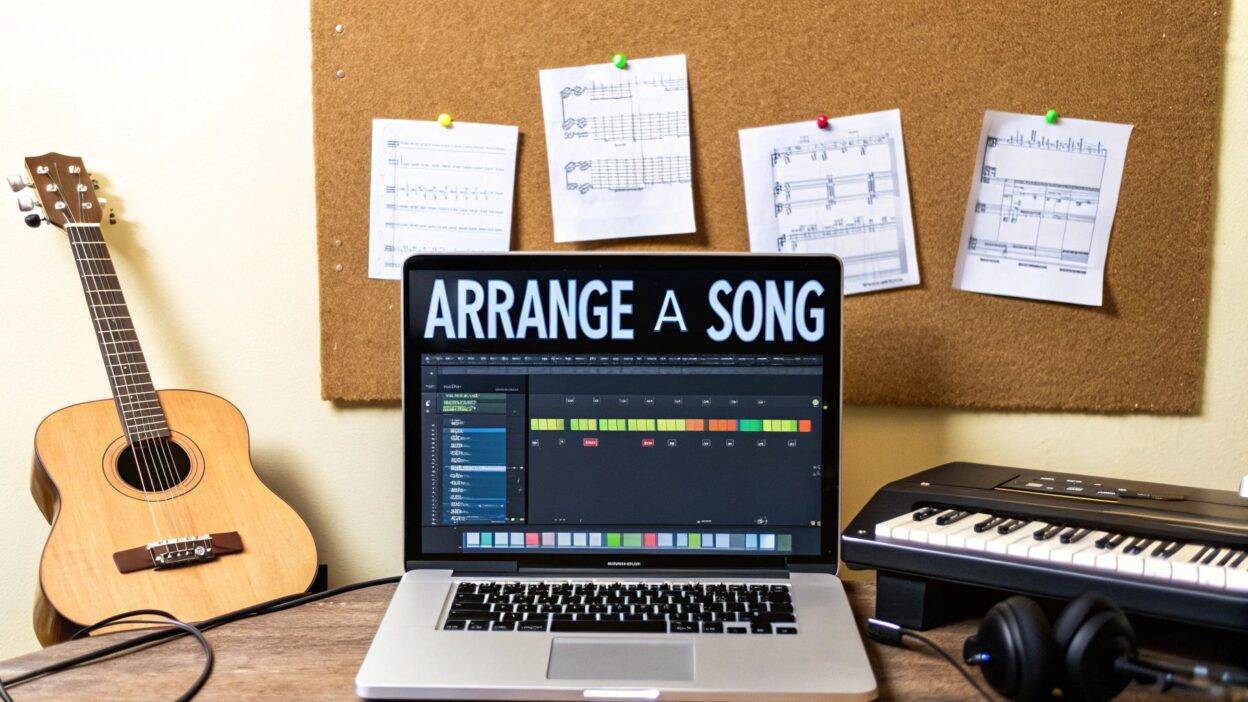The Real Foundation of Great Song Arrangements
Let’s cut through the noise. Learning how to arrange a song isn't about memorizing rigid formulas or following a dusty old textbook. The real secret weapon that separates an amateur demo from a polished, professional track is a mental shift. It's about moving beyond just writing chords and a melody and starting to think like an architect, designing an emotional journey for the listener from the very first note. This is the foundation that turns a simple idea into something that makes people hit repeat.
Great arrangements are built on a deep understanding of energy, psychology, and space. It's often less about what you add and more about why and when you add it.
Thinking in Layers and Space
Before you even start mapping out a verse or chorus, let's talk about the sonic landscape. A classic mistake is to cram every cool idea into the mix right from the start. This just creates a cluttered, muddy sound where nothing can breathe or stand out. Instead, imagine your song as a three-dimensional room.
- Frequency: Which instruments will own the low, mid, and high frequencies? If your bassline and a chunky low-end synth pad are battling for the same sonic real estate, you're going to get mud. Your job is to give each element its own pocket to live in.
- Panning (Stereo Field): Where will instruments sit from left to right? By placing a shaker slightly to the left and a hi-hat to the right, you create a much wider and more immersive feel than if everything is piled up in the center.
- Depth (Front to Back): You can use effects like reverb and delay to push some elements further back in the mix. This creates contrast, making other parts—like the lead vocal—feel like they're right up front and personal.
The Emotional Blueprint
Beyond the technical stuff, a great arrangement is a masterclass in storytelling. It’s the art of managing your listener's energy and expectations. This means creating a delicate balance between predictability and surprise, which is a huge factor in a song's commercial success. Pop arrangements have evolved from simple melody-and-rhythm formats into complex, layered experiences designed for maximum emotional impact.
A polished arrangement is so important that in the U.S. music market, a staggering 66% of songs on top global streaming playlists feature professional arrangements that directly contribute to their massive appeal. This isn't a fluke; it's a deliberate strategy. These songs craft an engaging journey with clear dynamic shifts, making choruses feel enormous and verses feel intimate. If you're curious about how market data shapes modern music, you can find more detailed insights on the U.S. music market here.
Building Song Structures That Hook Listeners From Start to Finish
Your song's structure is the roadmap for your listener’s emotional journey. Getting it right is what makes music truly connect. A well-thought-out structure guides them through the highs and lows, building anticipation and delivering those satisfying moments that stick with them. It’s all about arranging a song so it feels both comfortable and exciting—a delicate balance between what's expected and what's a surprise. Think of it less like a rigid formula and more like a flexible blueprint for creating an experience.
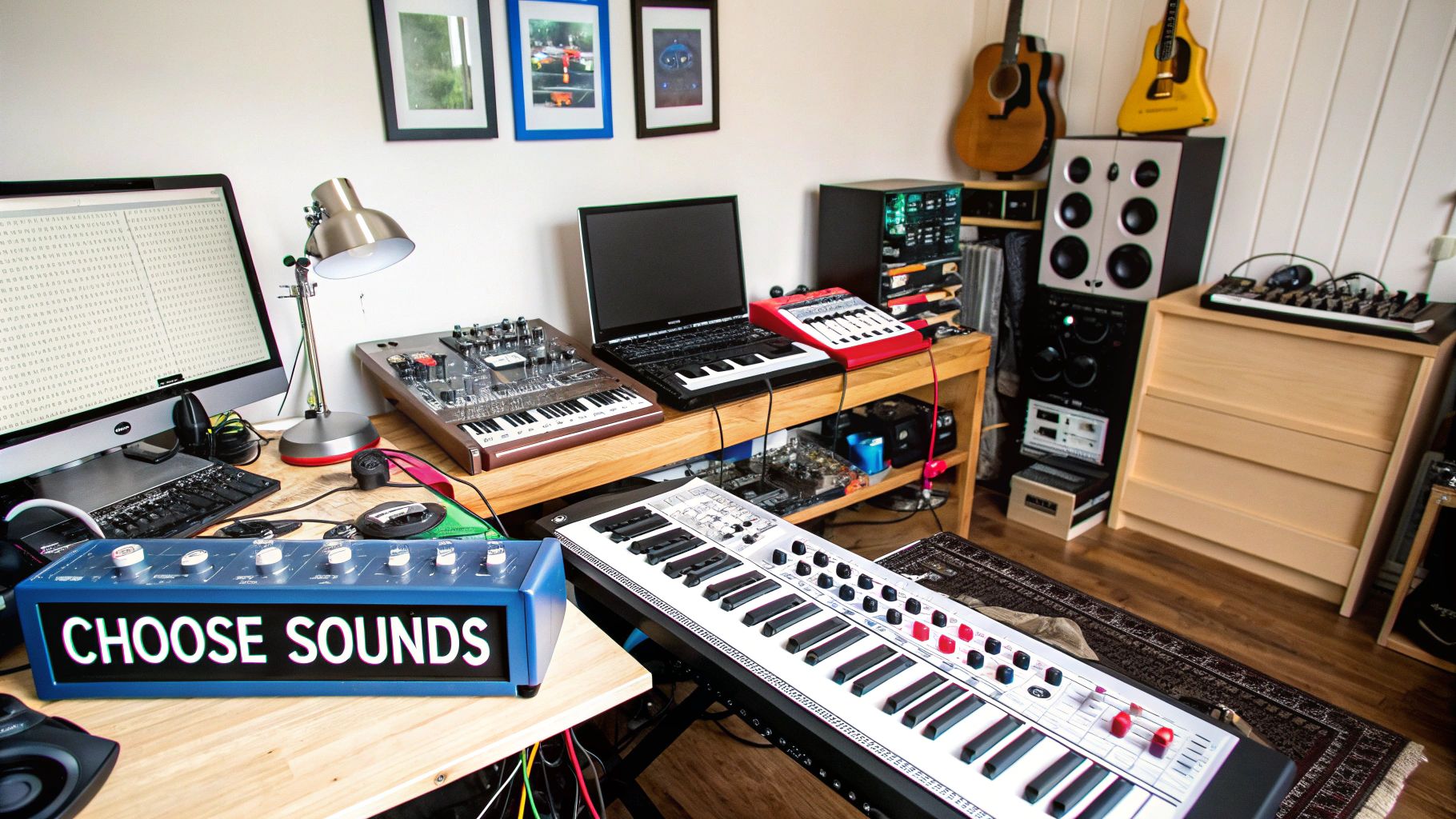
Common Building Blocks and Their Purpose
Most of the songs you love are probably built from the same handful of sections. Understanding why each one exists and the job it does is the first step to using them effectively in your own arrangements.
- Verse: This is where you tell your story. The energy is usually dialed back compared to the chorus, which gives you room to set the scene, develop a narrative, and pull the listener into the song's world.
- Chorus: This is the main event—the big, memorable payoff that captures the core idea of your song. It's almost always the loudest and most instrumentally full part, designed to be catchy and make people want to sing along.
- Bridge: The bridge is your chance to offer a change of scenery. It provides a fresh perspective, whether musically, lyrically, or both. Its job is to break the verse-chorus cycle, introduce a new emotional flavor, and build tension before that last, powerful return to the chorus.
- Pre-Chorus: Think of this as the ramp-up. It’s a short, transitional section that lifts the energy from the verse and builds anticipation right before the chorus hits. It makes the arrival of the hook feel even more impactful.
The Influence of Modern Listening Habits
The way people listen to music has changed, and that directly affects how we should arrange our songs. We aren't just arranging for the radio anymore; we're arranging for skips, playlists, and algorithms. In 2024, global recorded music revenues hit a staggering $29.6 billion, with streaming accounting for more than half of that. This shift has forced producers and arrangers to optimize songs for these platforms.
For example, intros are now often under 10 seconds to grab a listener's attention before they have a chance to skip. The average hit song is about 3 minutes and 20 seconds long—a length shaped by streaming payout models and data on listener retention. It's also why you hear hooks and choruses appearing within the first 30 seconds of a track. As the global music market keeps growing, with regions like the Middle East and North Africa expanding by nearly 23% annually, successful arrangers are also weaving in diverse regional sounds. This all goes to show that song arrangement has become a much more strategic, market-aware craft. You can dive deeper into these global music consumption trends for more details.
Smart Instrument Selection That Actually Works
Knowing how to arrange a song often boils down to one critical skill: picking the right instruments for the job. It's not about cramming more sounds into your project; it’s about strategically managing what I call sonic real estate. The goal is to give each instrument its own space to speak clearly without stepping on another's toes. This is the fastest way to avoid a muddy, amateur-sounding mix. Think of it like casting actors for a film—each one needs a distinct role to play.
A huge part of this is understanding frequency. A low, rumbling 808 bass and a thick, chunky acoustic guitar strumming low chords are both fighting for the same low-mid frequency range. When they play at the same time, they create a sonic traffic jam. Your job as an arranger is to be the traffic controller.
The Art of Pairing and Layering
The secret is to select instruments that complement each other naturally. For example, a crisp hi-hat sits in the high frequencies, leaving plenty of room for a melodic synth in the mid-range and a sub-bass holding down the low end. Each element has its own pocket to shine in, which is essential for creating clarity in your arrangement.
Here are some practical tips for effective instrument layering:
- Contrast is King: Pair a long, sustained synth pad with a short, plucky acoustic guitar. The difference in their articulation (how the notes are played) creates immediate interest and separation.
- Counter-Melody: If your lead vocal carries the main tune, try having a secondary instrument like a piano or a subtle lead guitar play a different, complementary melody in the gaps. This adds depth without creating clutter.
- Rhythmic Interplay: Don't have your kick drum and bass hit on every single beat together. Create a groove where they "talk" to each other. Maybe the bass plays on the off-beats, creating a syncopated feel that makes the track bounce.
To get a better handle on this, it helps to know where different instruments generally "live" in the frequency spectrum and what jobs they usually do. This table breaks down some common examples.
| Instrument | Frequency Range | Primary Role | Common Placement |
|---|---|---|---|
| Kick Drum | 50-100 Hz | Rhythmic Foundation | Low End |
| Sub Bass | 20-80 Hz | Foundational Lows | Low End |
| Acoustic Guitar | 80 Hz – 5 kHz | Harmony, Rhythm | Mid-Range |
| Piano | 30 Hz – 4 kHz | Melody, Harmony | Mid-Range |
| Vocals | 100 Hz – 3 kHz | Lead Melody, Focus | Mid-Range |
| Electric Guitar | 80 Hz – 5 kHz | Lead Melody, Rhythm | Mid-Range, High-Mid |
| Cymbals/Hi-Hats | 3 kHz – 20 kHz | Rhythmic Sparkle | High End |
| Synth Pads | 100 Hz – 8 kHz | Atmosphere, Harmony | Mid-Range, High-Mid |
Looking at this table, you can see how pairing a kick with cymbals naturally works—they operate in completely different frequency zones. Using this as a guide helps you make smarter choices from the start.
Blending the Organic and the Electronic
Modern production often blurs the lines between acoustic and digital sounds, and this is a powerful tool for arrangers. Layering a real, recorded shaker with a programmed drum machine hi-hat can add a human feel that a purely electronic beat might lack.
The reverse is also true: adding a deep synth bass beneath a live acoustic guitar can give it a modern, weighty foundation it wouldn't have on its own. If you’re just starting out, getting comfortable with these concepts is a great first step. For more foundational knowledge, you can explore our guide on music production for beginners. By thinking carefully about each instrument's role and frequency, you can build arrangements that sound full, professional, and emotionally resonant.
Mastering the Art of Musical Dynamics and Energy
A great song arrangement understands when to be quiet and when to shout. This control over dynamics—the shifts in loudness and intensity—is what drives your song’s emotional story. It’s how you craft those moments that make listeners lean in, holding their breath, and feel every note. When you think about how to arrange a song with dynamic contrast, you’re turning a flat recording into a living, breathing piece of art that keeps people engaged from the first beat to the last.
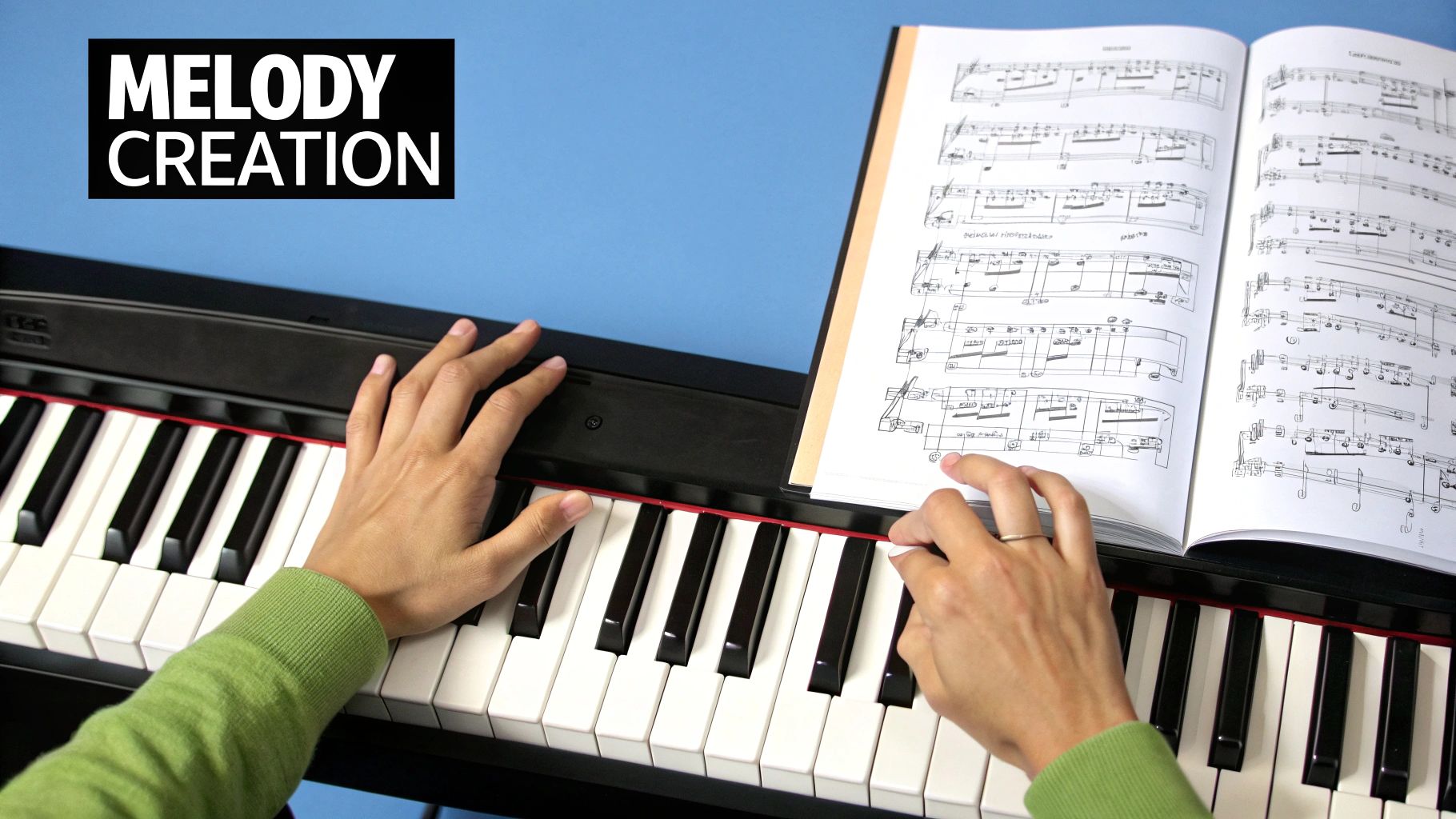
Building Tension and Delivering Release
At its heart, dynamic arrangement is all about the classic push-and-pull of tension and release. You build up anticipation and then provide a satisfying payoff. Just think of the pre-chorus in a huge pop anthem. Often, the instruments will thin out or the volume will drop right before the chorus comes crashing in. That brief moment of quiet makes the chorus feel absolutely enormous by comparison.
This isn't just a pop trick. A massive "drop" in electronic music follows the same logic. The energy swells with rising synths, frantic drum patterns, and filter sweeps, creating an almost unbearable tension. Then, for a split second, everything goes silent right before the main beat hits with full force. You can adapt this powerful idea to any genre you work in.
Practical Techniques for Dynamic Control
Creating these emotional peaks and valleys involves more than just nudging faders up and down. It’s a mix of changing the song's texture and adjusting the performance itself.
Here are a few actionable ways to manage the energy in your arrangement:
- Varying Textural Density: Instead of just making things louder, try adding or removing layers. A verse might start with just an acoustic guitar and a single vocal track. When the chorus hits, you can bring in the bass, a full drum kit, and layered harmonies. This shift in density naturally creates a lift without touching the volume knob.
- Performance Intensity: The way an instrument is played makes a huge difference. A drummer can lightly tap a hi-hat during the verse and then switch to smashing a crash cymbal in the chorus. A singer can use a breathy, close-up tone for one section and then deliver a powerful, belted vocal for another.
- Strategic Use of Silence: Don't underestimate the power of saying nothing at all. A complete stop or a "rest" just before a crucial lyric or a catchy instrumental hook can be incredibly effective. It makes the listener pay attention, creating a moment of intense focus.
By getting comfortable with these techniques, you're no longer just putting notes in order; you're sculpting an emotional journey for your listener. For even more ideas on how to polish your tracks, take a look at our collection of advanced music production tips.
Crafting Hooks and Transitions That Stick
The best-arranged songs just feel right. They seem like they couldn't have been written any other way. Their hooks grab you instantly, and their transitions guide you so smoothly that you barely notice the journey until you're already singing along to the next section. This seamless flow is where the real magic of knowing how to arrange a song comes into play. It’s all about creating those unforgettable moments—the earworms—and connecting them with bridges that feel both natural and exciting.
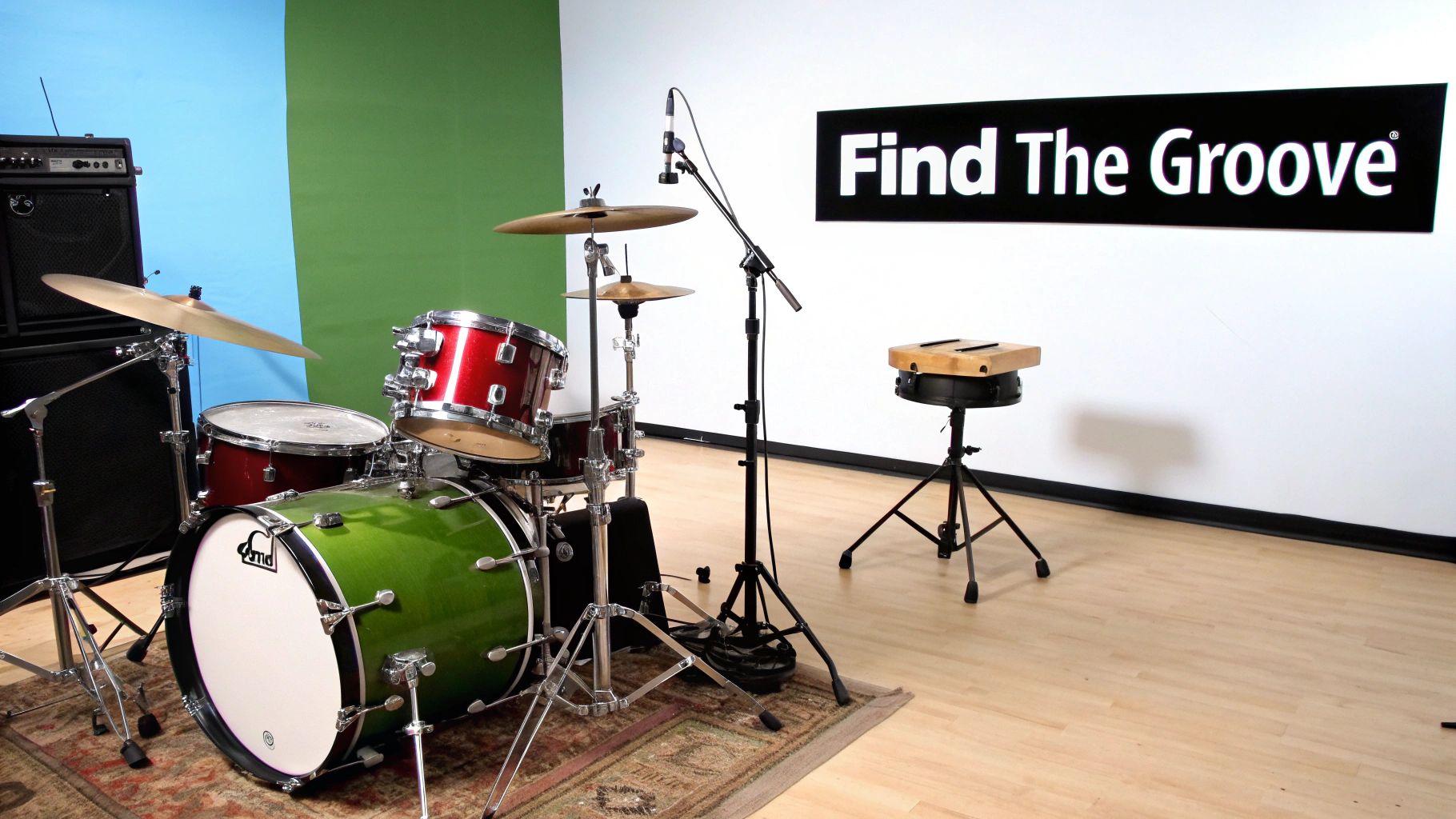
What Makes a Hook Work?
A great hook is more than just a catchy vocal melody; it can be any memorable musical idea. Just think about the iconic bassline in Queen's "Another One Bites the Dust" or the distinct drum beat that kicks off Billie Eilish's "bad guy." These are powerful rhythmic hooks that are just as memorable as any vocal line.
Your hook could be:
- A Melodic Phrase: This is the most common type, like a standout vocal line in a chorus.
- A Rhythmic Pattern: A unique drum groove or bassline that defines the song's entire feel.
- A Harmonic Progression: A specific chord change that feels fresh and satisfying every time you hear it.
- A Textural Sound: A distinct synth patch or guitar tone that instantly identifies the track.
The secret is repetition with slight variation. You repeat the hook enough for it to become familiar, but you subtly change its context—maybe by layering a new harmony underneath it or presenting it on a different instrument—to keep things interesting. If you're looking for more ways to generate these initial sparks of inspiration, our guide on songwriting tips for beginners can help you get started.
Creating Transitions That Feel Inevitable
Transitions are the glue holding your arrangement together. A clunky, awkward transition can completely pull a listener out of the experience. The goal is to make the move from a verse to a chorus, or from a bridge to an outro, feel like a logical and satisfying next step.
One of the most effective techniques is using a riser or a drum fill. A simple cymbal swell or a short, tense drum pattern signals that a change is coming, building anticipation for the payoff of the next section. Another powerful tool is the call-and-response pattern, where one instrument poses a musical "question" that the next section "answers."
This art of balancing memorability and flow is a global practice. For instance, top European markets, contributing over $8 billion to recorded music revenues, often favor sophisticated arrangements with intricate harmonies. Meanwhile, markets in Sub-Saharan Africa, which saw an incredible 24.7% growth driven by streaming, have found global success by weaving local rhythmic patterns into their song structures. This just goes to show that cultural authenticity can be a powerful hook in itself. You can learn more about how market trends shape modern music arrangements in recent industry reports.
Genre-Specific Arrangement Strategies That Work
Every genre has its own musical language. If you want to figure out how to arrange a song that really connects, you first have to get fluent in the style you’re working with. An arrangement that sounds amazing for a soft folk ballad would feel completely wrong in a high-energy progressive rock track. The secret is to understand the core DNA of a genre so you can build something that feels authentic to its listeners.
Think about it like this: a hip-hop arrangement is all about the groove—the kick, snare, and bassline lock in to create a solid pocket for the vocals. On the flip side, a jazz arrangement might prioritize complex chord voicings and leave plenty of room for musicians to improvise. It’s less about following strict rules and more about knowing what the audience expects and enjoys.
Common Genre Conventions
Getting a handle on these conventions gives you a solid foundation. Once you know them, you can choose to stick close for a classic sound or intentionally break them to create something fresh and unexpected.
- Pop Music: The focus is on a big, memorable chorus packed with layers of instruments. Verses are often kept simpler to build contrast and make that chorus hit even harder. The lead vocal is always the star of the show.
- Folk/Acoustic: This style is usually more intimate and stripped-down. The arrangement often centers on just one or two core elements, like an acoustic guitar and a voice, keeping the layers minimal to let the raw emotion shine through.
- Rock Music: Driven by the powerful interplay between electric guitars, bass, and drums. The energy builds and recedes dramatically, with huge choruses and often an instrumental solo section as a centerpiece.
- Hip-Hop: The beat is everything. The drum pattern and bassline are the foundation, creating a hypnotic groove. Samples, synths, and other melodic bits are layered in to add texture and mood without getting in the way of the vocal delivery.
To give you a clearer idea of how these conventions play out in different genres, here’s a table breaking down their typical characteristics.
| Genre | Typical Structure | Key Instruments | Dynamic Approach | Common Techniques |
|---|---|---|---|---|
| Pop | Verse-Chorus-Verse-Chorus-Bridge-Chorus | Vocals, Synths, Drum Machines, Bass | High contrast between sparse verses and dense choruses. | Catchy hooks, heavy vocal processing, layered harmonies. |
| Rock | Verse-Chorus-Verse-Chorus-Solo-Chorus | Electric Guitar, Bass, Drums, Vocals | Gradual builds and sudden drops; high energy. | Power chords, guitar riffs, drum fills, dynamic solos. |
| Folk/Acoustic | Verse-Chorus or Strophic (Verse-Verse-Verse) | Acoustic Guitar, Vocals, Harmonica, Light Percussion | Generally consistent and intimate; subtle dynamic shifts. | Fingerpicking, simple chord progressions, raw vocal takes. |
| Hip-Hop | Intro-Verse-Chorus-Verse-Chorus-Outro | Drum Machine (808s), Sampler, Synths, Vocals | Repetitive groove-based dynamics; focus on rhythm. | Sampling, looping, heavy bass, ad-libs, syncopated flows. |
| Jazz | Head-Solos-Head (AABA or 12-Bar Blues) | Piano, Double Bass, Drums, Horns (Sax, Trumpet) | Interactive and fluid; dynamics follow improvisation. | Improvisation, complex chords, swing rhythms, "call and response." |
As you can see, the genre dictates everything from the song's roadmap to its instrumentation and energy flow. Using this as a guide helps ensure your arrangement decisions support the song's core identity.
To visualize this further, the chart below shows how instrumental layers and bar counts typically change between sections in a standard pop song.
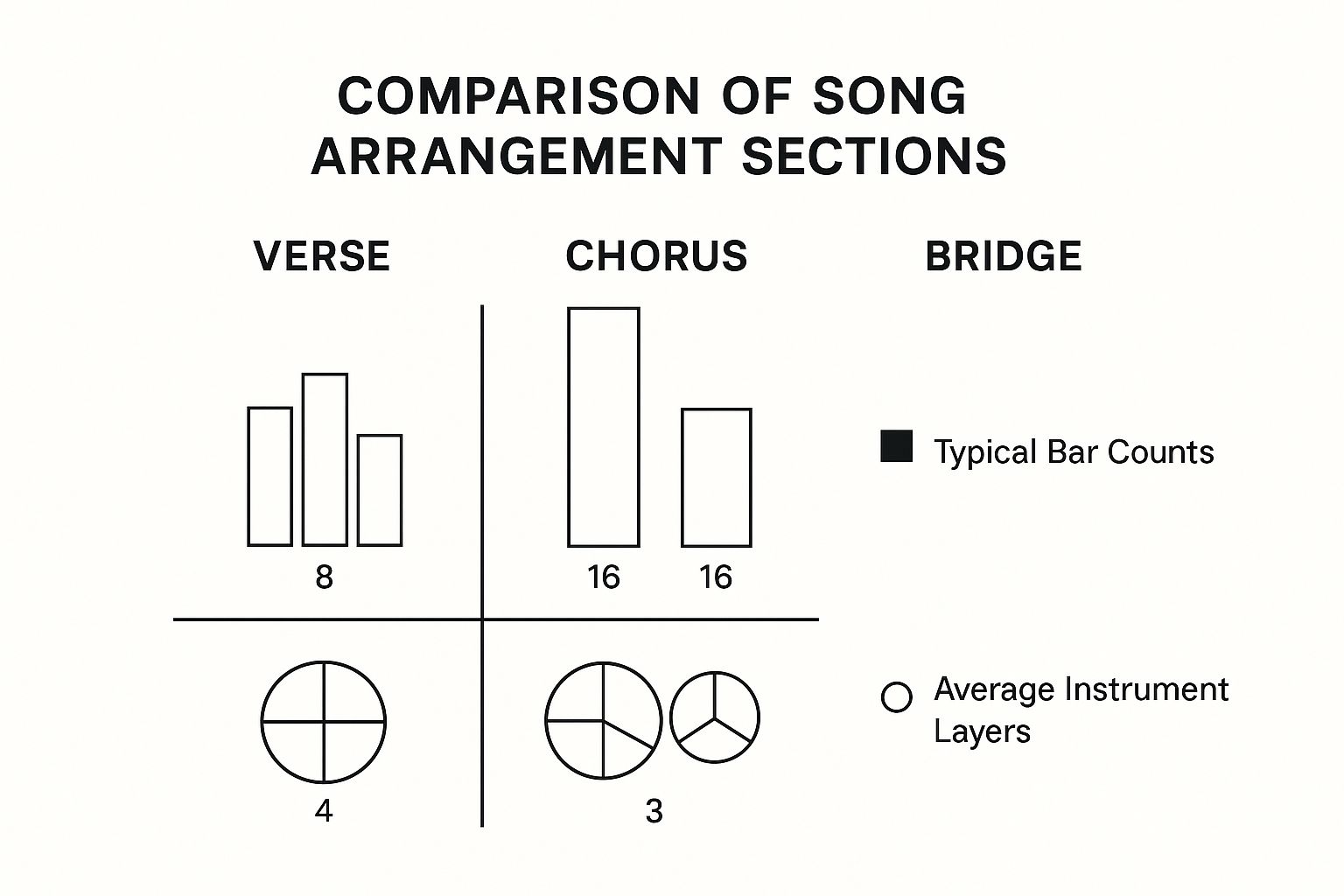
Notice how the chorus is not just longer but also has more instrumental layers. This is a deliberate choice to create that big, impactful moment everyone remembers. In contrast, the bridge often strips things back to offer a different feel before the final chorus. Understanding these fundamental differences is your first step toward crafting arrangements that truly serve the song, no matter the style.
Polishing Your Arrangements to Professional Standards
Taking your arrangement from 90% to 100% complete is where the magic really happens. This final polishing phase is what elevates a good demo into a professional, industry-ready track. It's all about stepping back, listening with a fresh perspective, and making the small, critical tweaks that create a huge impact. Knowing how to arrange a song to this level means becoming your own toughest critic and identifying what problems to listen for.
Getting Fresh Ears and Honest Feedback
After you’ve spent hours, or even days, immersed in an arrangement, you start to lose objectivity. The single best thing you can do is take a break—I recommend at least a full day—before you listen again. When you come back to it, play the track on every system you have access to: your studio monitors, the car stereo, cheap earbuds, and your laptop speakers. This simple trick will immediately highlight mixing and arrangement issues you were completely deaf to before.
On top of that, getting honest feedback is non-negotiable. Don't just play it for friends who will tell you "it sounds great!" Find other musicians or producers whose ears you trust. Instead of asking for general thoughts, ask specific questions to get actionable advice:
- Does the energy drop anywhere it shouldn't?
- Is any part of the song confusing or cluttered?
- Does the chorus feel as big and impactful as it could?
This kind of targeted feedback gives you a concrete to-do list, not just a vague compliment.
Prepping for Collaboration and Final Mixdown
A polished arrangement isn't just for you; it's about making life easier for everyone else involved, especially a mixing engineer. This means tidying up your project file. Label every single track clearly (e.g., "Verse Gtr 1," "Chorus Bass," "Bridge Pad"). This small organizational step is a professional courtesy that also forces you to think clearly about each element's specific role in the song.
The image below shows a traditional musical score. This is how arrangers historically documented their ideas so other musicians could follow along and perform the piece correctly.
In a modern digital audio workstation, your track layout serves the exact same purpose. It communicates your creative vision to collaborators. Clearly documenting your arrangement choices—what plays where and why—is a hallmark of professional work that ensures your ideas translate perfectly into the final mix.
At ChordX, we believe a great arrangement is the blueprint for a successful song. Our guides and tutorials are designed to help you master these finishing touches, turning your musical ideas into polished tracks that stand out. Explore more resources at ChordX.io to continue refining your skills.
